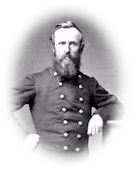January 26, 1864. — Another large squad of veterans and the most of the remaining officers left for Ohio yesterday. Recruiting seems to be active in Ohio. I think we shall get our share.[1]
Plan of spring campaign from Kanawha Valley. — Ten or fifteen thousand men can move from the head of navigation on the Kanawha River (Loup Creek) via Fayette, Raleigh, Flat Top, and Princeton to the Virginia and Tennessee Railroad between New River and Wytheville, a distance of one hundred and thirty-nine miles, in a week or ten days; spend a week on the railroad destroying New River Bridge and the track for twenty-five miles; return to Loup Creek in one week more and be carried in steamers into the Ohio, and thence East or South for other operations. One week is time enough to convey such a force to Loup Creek from the Potomac or the West. The roads and weather will ordinarily allow such a column to move April 20. Supplies and transportation should be provided at Fayette during February and March. The utmost secrecy should be observed so that the first information the Rebels would have would be the approach of the force. Such a destruction of the railroad would effectually cut the communications of Longstreet and Jones in east Tennessee and compel him [the enemy] to abandon that country. The Rebels could not reconstruct the railroad during the next campaign. It would perhaps compel the evacuation of Richmond.
[1] A Columbus dispatch of February 14, in the Cincinnati Gazette, had this paragraph: — “It has been ascertained at the muster-in office, that the Twenty-third Ohio, Colonel R. B. Hayes, Department of West Virginia, was the first regiment from this State to enlist as veterans. Several regiments have claimed that honor.”



